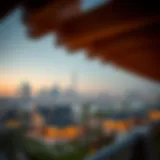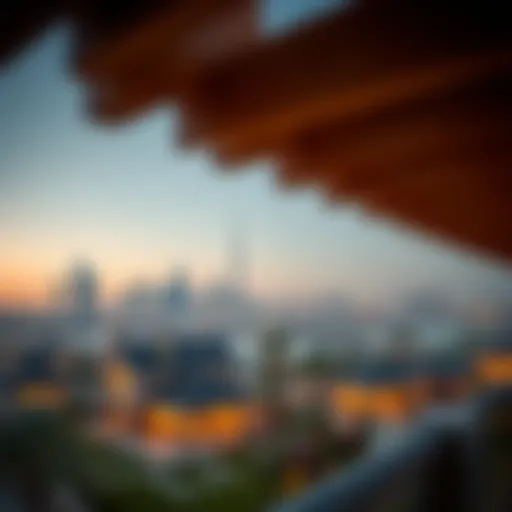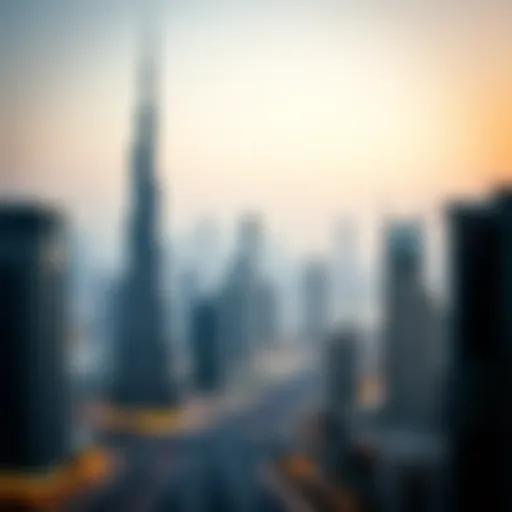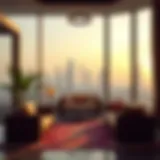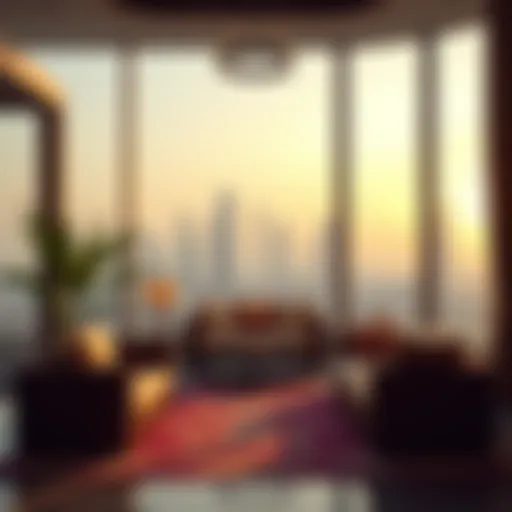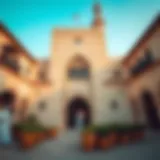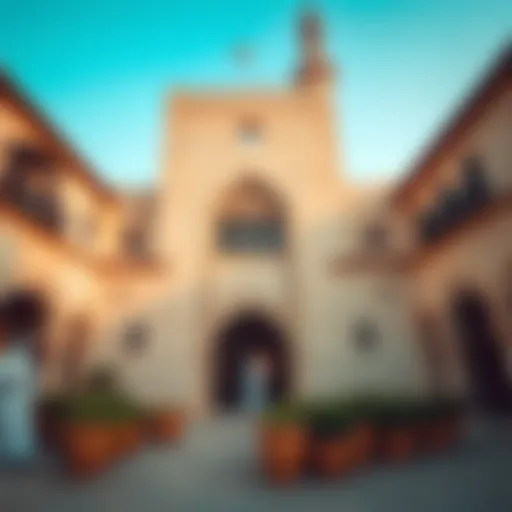Exploring Palm Tower: Its Influence on Dubai's Real Estate


Intro
As the sun sets over the iconic skyline of Dubai, one structure rises distinctly—برج النخلة, or Palm Tower. This architectural marvel is not just a visual spectacle; it signifies a pivotal shift in Dubai's real estate narrative. The Palm Tower symbolizes luxury and sophistication, providing a comprehensive insight into the market forces shaping the emirate’s property landscape. In this article, we will probe into the core aspects surrounding this celebrated development, exploring its impact on the real estate market, and examining trends that are driving the investment appetite among buyers, developers, and investors alike.
Market Trends
Current Real Estate Trends in Dubai
Dubai's real estate market has seen a remarkable revival, marked by a blend of luxury developments appealing to an international audience. The city's diverse property offerings, from exquisite apartments in برج النخلة to sprawling villas in other upscale neighborhoods, cater to a variety of tastes and budgets.
A few vital trends emerge from the current landscape:
- Increased Foreign Investment: Investors from Europe, Asia, and the Middle East are flocking to Dubai, attracted by favorable market conditions and tax incentives.
- Focus on Sustainability: As the global awareness of environmental issues grows, many developers are integrating sustainable practices and green building certifications into their projects.
- Shifting Demographics: With a rise in younger residents, the demand for chic living spaces that offer amenities and social engagement has surged.
Future Forecasts for the Dubai Property Market
Looking ahead, the outlook for Dubai's property market remains optimistic, driven by several key factors:
- Expo 2020's Long-term Effects: Although postponed, the legacy of Expo 2020 continues to generate interest in Dubai as a hub for business and tourism.
- Continued Infrastructure Development: Investments in transportation and amenities signal that Dubai is not slowing down, promising further growth in property values.
"Investors are becoming increasingly discerning, looking beyond mere capital appreciation to the lifestyle benefits associated with properties like برج النخلة."
Property Types
Residential Properties: Overview and Insights
برج النخلة is not merely a residential project; it represents the epitome of luxury living in Dubai. The residences offer breathtaking views, ultra-modern interiors, and access to world-class facilities, making them highly sought after. The growing inclination towards high-end living spaces aligns with the broader trend of affluent buyers prioritizing exclusivity over quantity.
Key characteristics of residential houses in برج النخلة include:
- Prime Location: Nestled amid iconic landmarks, it enhances both lifestyle and investment potential.
- Luxury Amenities: Features such as a rooftop infinity pool and fine dining options add to the allure of these homes.
- Strong Rental Yields: For investors, these properties promise healthy returns, driven by the ongoing demand for luxury accommodations.
Commercial Properties: Opportunities and Challenges
While برج النخلة predominantly focuses on residential offerings, its impact on the commercial sector is equally noteworthy. The development is strategically positioned to accommodate retail spaces and offices catering to high-end clientele, fostering synergy between luxury living and commerce.
Challenges do loom, including:
- Market Saturation Risk: With numerous new developments on the horizon, balancing supply and demand will be critical.
- Economic Factors: Fluctuating global markets can influence expatriate investment patterns and consumer spending, impacting commercial performance.
In summary, برج النخلة stands not only as a hallmark of architectural brilliance but also as a vital player in shaping the future of Dubai’s real estate landscape. It embodies the complexities of the market while offering investors and residents alike a tantalizing glimpse into what is possible in this ever-evolving city.
For further understanding of real estate dynamics in Dubai, consider resources like Wikipedia and Britannica.
Prologue to برج النخلة
In the realm of architectural wonders that grace Dubai’s skyline, برج النخلة stands out as a symbol of luxury and innovation. Understanding Palm Tower is not merely an exploration of a physical structure, but a detailed examination of how it intertwines with the larger narrative of Dubai’s hospitality and real estate dynamics. The Palm Tower represents a distinct milestone in Dubai’s ever-evolving landscape, influencing both potential homeowners and investors alike. Delving into the unique features of this tower provides insights into its significance in shaping market trends and lifestyle choices in this thriving city.
Historical Background
The history of Palm Tower is as storied as its aesthetic is striking. The concept was born out of Dubai's ambition to create iconic landmarks that would draw visitors and investors from around the globe. Originally part of the Palm Jumeirah, an undertaking that transformed the coastal geography of Dubai, the construction of the tower began in earnest in 2017 and took several years to reach completion.
During its development, Palm Tower faced myriad challenges—from regulatory hurdles to economic fluctuations. Yet, its eventual completion in 2021 marked a new chapter in Dubai's architectural narrative. The tower not only enhanced the skyline but also solidified Palm Jumeirah's reputation as a premier residential and tourism destination.
This historical backdrop serves as a reminder of Dubai's resilience and vision in the face of challenges, as well as the aspirations that drove the creation of such an impressive structure.
Architectural Overview
At a glance, Palm Tower’s design is a feast for the eyes. Standing tall at nearly 240 meters, it captures an essence of modernity while integrating details that pay homage to local architectural traditions. The tower’s unique silhouette is inspired by the palm tree, a fitting tribute in a city that has embraced this symbol as a representation of growth and prosperity.
Internally, the structure houses 52 floors with residential options ranging from one-bedroom apartments to luxurious penthouses offering stunning views over the Arabian Gulf. Incorporating eco-friendly materials and cutting-edge technology, the design is both functional and forward-thinking. The use of expansive glass panels ensures natural light floods the spaces while providing panoramic vistas of the city.
Palm Tower's architectural prowess doesn’t end with just aesthetics; it integrates smart home technologies ensuring residents experience unparalleled comfort and convenience. Furthermore, a striking observation deck located at the pinnacle offers an immersive experience for both residents and visitors, becoming another attraction for an already vibrant locale.
In summary, the architectural overview of برج النخلة provides a comprehensive understanding of its role not just as a stack of floors, but as a catalyst for urban development and real estate growth in Dubai.
Design Features of Palm Tower
When it comes to defining the character of برج النخلة, or Palm Tower, the design features play a crucial role. The aesthetic and functional elements that make up this monumental structure not only contribute to its visual prominence on Dubai’s skyline but also affect its livability and investment potential. These features appeal to a range of stakeholders, from prospective homeowners seeking luxurious living spaces to developers and investors eyeing long-term gains.
Structural Composition
At the heart of Palm Tower’s success is its groundbreaking structural composition. Standing tall at 240 meters, this striking tower is an architectural marvel that showcases modern engineering techniques. The framework is primarily constructed from reinforced concrete complemented with steel reinforcements. This blend allows for an impressive balance of safety and flexibility, essential in a region prone to seismic activities.
Several innovative techniques were employed during its construction. For instance, the use of slip-form construction enabled the seamless pouring of concrete, which significantly expedited the build.
- Wind Engineering: It's crucial for a skyscraper to withstand strong winds. Palm Tower’s aerodynamic shape reduces wind load, enhancing stability.
- Foundation Design: The building rests on a deep foundation system, which includes piles and mat foundations. This design is vital for the heavy structure, ensuring resilience and long-term stability.


These elements not only enhance the safety and durability of the building but also reflect a commitment to cutting-edge practices in the construction industry.
Interior Design Elements
While the structural composition offers safety, it’s the interior design that enchants residents and visitors alike. Palm Tower is adorned with luxurious finishes that exemplify elegance and sophistication. The design aims to foster a sense of tranquility amid the bustling surroundings of Dubai.
The interior spaces are meticulously planned, featuring high ceilings and large windows that invite natural light to flood in. This enhances the overall living experience by creating airy, bright spaces that feel open and inviting.
- Materials: The use of premium materials like marble, hardwood, and designer fixtures adds to the luxury feel. Each unit tells a story of class and comfort.
- Smart Home Integration: Palm Tower incorporates the latest smart home technologies, allowing residents to control their environment with ease. From lighting to climate control, these elements provide convenience and energy efficiency, aligning with modern living trends.
The mix of luxurious aesthetics with functionality creates a unique living experience, setting Palm Tower apart from other properties in the neighborhood.
"Palm Tower isn't just another building; it’s a lifestyle choice that reflects the aspirations of modern living in Dubai."
Luxury Amenities and Offerings
The significance of luxury amenities in برج النخلة cannot be overstated. In an era where lifestyle and comfort are paramount, the offerings within Palm Tower set a benchmark for modern living in Dubai. The integration of high-end features not only enhances the residents’ daily life but also serves as a powerful magnet for prospective investors. With the right amenities, the project is positioned not merely as a place to live but as a lifestyle choice, influencing the overall real estate landscape in Dubai.
Residential Units
When it comes to the residential units in برج النخلة, they stand to be a game-changer in the property market. The variety in unit types—from spacious 1-bedroom apartments to sprawling penthouses—caters to a diverse demographic, ensuring that nearly anyone looking for a home has something to consider. High ceilings, large windows, and top-quality finishes create an ambiance of luxury and openness.
Additionally, smart home technology is likely to become standard in these residences, offering features that can make daily life easier and more convenient. Imagine controlling your lights and heating from your phone, or receiving notifications from a security system directly to your device. These features not only align with contemporary living standards but also enhance the overall value of the property.
"In a world where first impressions matter, the residential offerings at Palm Tower surely set the stage for something extraordinary."
Public Spaces and Attractions
Public spaces and attractions around برج النخلة play a crucial role in its allure. These areas typically feature an array of dining options, retail outlets, and recreational facilities, fostering a vibrant community atmosphere. Particularly, the integration of parks, landscaped gardens, and leisure facilities enhances the liveability quotient of the area.
The rooftop observation deck is poised to become a significant draw, providing panoramic views of Dubai’s spectacular skyline, drawing tourists and locals alike. Such attractions not only enhance the experience for residents but also create opportunities for businesses around the tower to thrive.
Moreover, offering a state-of-the-art fitness center and a wellness spa complies with today’s health-conscious culture. Access to these facilities reinforces a sense of community among residents and adds significant value to any potential investment.
Overall, the cumulative offering of residential units and public spaces creates a holistic living environment, appealing to both end-users and investors. This comprehensive luxury approach makes برج النخلة a prime candidate for anyone looking to invest in the Dubai market.
Investment Opportunities
When one looks at برج النخلة, the potential for investment is pretty much glaringly obvious. Not only does this landmark aspire to redefine the skyline of Dubai, but it also serves as a magnet for investors who are keen on tapping into the ever-evolving real estate market of the city. One cannot ignore the importance of diving into the specifics of investment opportunities tied to Palm Tower. Understanding these aspects provides critical insights for anyone wanting to dip their toes into Dubai's lucrative property sector.
Market Analysis
Right off the bat, let's talk numbers. The real estate market in Dubai has been through its fair share of ups and downs. However, recent trends indicate that the demand for luxury properties is on the rise. Palm Tower is strategically located at the heart of Palm Jumeirah, which is synonymous with luxury living. Investors should note that properties in such prime locations typically witness increased demand, leading to higher returns over time.
For instance, recent data from property market analysis shows a steady increase in transaction volumes for high-end properties in Dubai, particularly in areas like Palm Jumeirah. Buyers are increasingly paying a premium for properties that promise a mix of luxury amenities and stunning views. This trend is expected to continue, especially as the tourism sector regains momentum post-pandemic.
Property Valuation Trends
An essential piece of the puzzle in any investment decision is understanding property valuation. The valuation trends surrounding برج النخلة are particularly interesting. As this tower aims to provide exclusive offerings, its valuation reflects not just the intrinsic value of the property itself, but also the anticipated future value based on its luxury status.
To break things down:
- Increased Demand: As mentioned, the demand for luxury units in Dubai is rising. This trend pushes property values upward, making now a prime time to invest.
- Comparative Market Analysis: When looking at similar properties such as those in the Burj Khalifa or One Za'abeel, it becomes evident that price increases are common in these luxury brackets. Investors can juxtapose these properties to assess projected valuations for Palm Tower.
- Future Developments: The surrounding infrastructure and ongoing developments in Palm Jumeirah will further enhance the value of برج النخلة. Increased connectivity and new attractions will only make this area more desirable.
"Investing in luxury real estate is often viewed as a hedge against market volatility. The allure lies not just in comfort, but in the promise of sizable returns."
Those looking to dive deeper into the nuances of this investment landscape may find valuable resources at Encyclopedia Britannica, or property-specific forums and discussions on Reddit.
With this dynamic backdrop, it's clear that those who act wisely can carve a niche in this fast-paced market.
Comparative Analysis with Other Iconic Developments
When assessing the significance of برج النخلة, a comparative analysis with other iconic structures becomes pivotal. It isn't just about how Palm Tower stands on its own, but how it fits within the realm of global architectural marvels. This perspective can reveal its true impact on Dubai's real estate landscape and the factors that define its allure.
Understanding the contrasts and similarities with notable developments like the Burj Khalifa and One Za'abeel can provide valuable insights for investors, homebuyers, and industry professionals. Here are some key considerations in this comparative analysis:
- Architectural Significance: Comparing design philosophies can highlight how unique or conventional the Palm Tower’s architecture is.
- Cultural Representation: Each structure reflects a different facet of Dubai’s identity, advancing the narrative of progress or tradition in the city.
- Market Positioning: Analyzing pricing strategies and target demographics can illuminate trends in investor behavior and consumer confidence.
In summary, this comparative angle not only sheds light on the Palm Tower’s competitive edge but also enriches our understanding of its role in shaping the local market dynamics.
Burj Khalifa
Arguably one of the most recognized structures in the world, the Burj Khalifa is more than just a landmark; it symbolizes Dubai's rapid ascent on the global stage. Standing at a staggering height, it serves both as a feat of engineering and a symbol of luxury. The Burj amplifies the concept of vertical living, catering to high-end clientele looking for exclusive experiences.
- Height and Prestige: With a height of 828 meters, it remains the tallest structure globally, attracting tourists and residents alike, which creates a different benchmark for Palm Tower.
- Investment Returns: Rental yields and sales prices around the Burj Khalifa have often set a standard, offering vital data for investors evaluating potential returns on their properties situated nearby.
- Cultural Venues: The Burj Khalifa is surrounded by various cultural venues, including the Dubai Mall and the Dubai Fountain, framing it as an entertainment focal point that Palm Tower also seeks to capitalize on.
Such comparisons underline that while Palm Tower might aim high, it is surrounded by titanic expectations and precedents.
One Za'abeel


One Za'abeel, part of the Dubai World Trade Center, is yet another titan influencing the real estate landscape. While it is not as tall as the Burj Khalifa, it stands out for its architectural innovation, notably known for its unique design and the promise of luxury office spaces.
- Deconstructing Design: One Za'abeel's design, with its striking tapering silhouette, positions it as a rival in terms of aesthetic appeal. It showcases modern engineering capabilities that could challenge the architectural ingenuity of Palm Tower.
- Corporate Appeal: Its focus on office spaces and business amenities may shape investor interest differently compared to Palm Tower's more residential and leisure-oriented offerings.
- Bridging Communities: The location aims to connect business hubs with residential areas, which is something Palm Tower also aspires to, blending the essence of lifestyle with professional growth.
Impact on Local Real Estate Market
Understanding the impact of برج النخلة on Dubai's local real estate market provides insights into broader economic trends, investment opportunities, and buyer preferences. The tower is not just a marvel of architecture; it serves as a bellwether for the health of the property market in Dubai. Specifically, we can look into two key areas: economic implications and shifts in buyer demographics.
Economic Implications
The economic ripple effects of برج النخلة on the local market are significant. This tower has transformed the Palm Jumeirah area into a hotspot for investment and luxury living. The development creates numerous jobs, from construction to hospitality and management, benefiting the local labor market.
"The integration of برج النخلة has intensified economic activity not only in the immediate vicinity but across Dubai due to increased foot traffic and international attention."
Moreover, the property market has been revitalized, driven by the high demand for luxury apartments that this tower offers. As investors flock to the region, we can see a surge in property prices, which, while advantageous for sellers, also raises questions about affordability for potential buyers. This scenario prompts a closer examination of how such trends affect overall market stability.
Additionally, برج النخلة's presence enhances Dubai’s reputation as a global business hub. Foreign investment flows into the area, contributing to further developments and infrastructure improvements. The increase in property values can be seen as both a boon and a challenge, requiring strategic planning to manage growth and sustain the community’s needs.
Changes in Buyer Demographics
The allure of برج النخلة significantly influences the demographic profile of property buyers in Dubai. Traditionally, the city attracted a broad spectrum of buyers; however, the tower's luxury offerings are shifting this landscape.
Today, prospective homeowners are often more affluent and have diverse backgrounds. They include not only expatriates seeking a luxurious lifestyle but also investors drawn in by the tower’s prestigious location and associated perks. Some of these buyers are looking for investment properties rather than personal residences, which adds layers to market dynamics.
Factors contributing to these demographic changes include:
- Increased interest from international investors, particularly from Europe and Asia.
- A rise in young professionals and affluent families seeking premier living spaces in integrated communities.
- An influx of retirees attracted to the amenities and stability offered by projects like برج النخلة.
The evolution of buyer demographics means that developers and investors must adapt to meet changing expectations and preferences. From eco-friendly designs to smart home technology, the integration of contemporary features becomes essential in attracting this new wave of buyers.
By scrutinizing both economic implications and demographic shifts, stakeholders can better navigate the complexities offered by برج النخلة, ensuring that they leverage opportunities while addressing challenges that come with rapid growth in the market.
Community and Lifestyle Integration
Community and lifestyle integration is critical in shaping the environmental and social fabric of large-scale developments like برج النخلة. This aspect touches upon how well the surrounding ecosystem, no matter if it’s local residents, businesses, or visitors, engages with the Palm Tower.
In a city where innovation meets tradition, Palm Tower is designed not just as a luxury structure, but also as a hub that blends seamlessly with Dubai’s vibrant lifestyle. The tower sits at the heart of the Palm Jumeirah, a landmark that’s as much about leisure and culture as it is about contemporary living. The integration of the tower into the community emphasizes the significance of creating a living experience that caters to the well-rounded needs of its residents.
Cultural Impact
The cultural impact of برج النخلة extends beyond its impressive architecture; it’s about creating a place where art, traditions, and modernity coalesce. Here, culture is not a backdrop; it’s woven into the very fabric of daily life. The tower hosts various cultural events and artistic endeavors that encourage local and international artists to showcase their work.
Moreover, the Palm Tower gives ample space for cultural interactions through its communal areas which include galleries, exhibition spaces, and performance arts centers, allowing residents and visitors to immerse themselves in cultural activities. Citizens and expatriates alike find a sense of belonging in shared celebrations, whether during national holidays or local festivals.
To illustrate, consider the annual Dubai Shopping Festival which beckons foot traffic and tourists alike, creating opportunities for community bonding as residents experience Dubai through both local perspectives and international influences.
"The cultural vibrancy of a city is measured through its integration of diverse lifestyles and traditions that collectively create an inclusive atmosphere."
Recreational Opportunities
Recreational opportunities around برج النخلة are nothing short of extraordinary. The Palm Tower is strategically located, allowing easy access to a multitude of leisure activities. Residents can enjoy picturesque walks along the beach, take part in water sports, or relax in one of the many lush green parks nearby.
The tower’s rooftop lounge is a notable highlight, offering not only breathtaking views of the Palm Jumeirah but also an exceptional gathering place that encourages socializing among residents.
Some features that add to the recreational landscape include:
- Fitness amenities: A state-of-the-art gym and swimming pool cater to the health-conscious, promoting an active lifestyle.
- Family-friendly activities: Children’s play areas and community centers foster a sense of family and community.
- Culinary experiences: A variety of dining options around the tower offer diverse cuisines, from casual eateries to high-end restaurants, providing something for every palate.
For those who thrive in a community-centric environment, Palm Tower offers a promising blend of lifestyle, leisure, and culture.
Sustainability Considerations
Sustainability in real estate has become more than just a buzzword; it's a necessity. As developments like برج النخلة become prominent in the urban landscape of Dubai, integrating sustainable practices is crucial. The importance of sustainability lies not only in environmental preservation but also in enhancing the long-term viability and attractiveness of such properties to investors and residents alike. By focusing on sustainable elements, developers not only adhere to global standards but also create a lasting legacy.
Environmental Standards
Environmental standards in construction are pivotal. The Palm Tower has incorporated a variety of strategies aimed at minimizing its ecological footprint. For instance, the use of green materials significantly reduces reliance on non-renewable resources. Materials like recycled steel, wood sourced from sustainably managed forests, and energy-efficient glass solutions are just a few examples. Furthermore, water conservation strategies are implemented through advanced infrastructure, including reclaimed water systems for landscaping. This conscious effort reflects a commitment not only to beautiful designs but also to ecological responsibility.
- LEED Certification: Aiming for a LEED (Leadership in Energy and Environmental Design) certification demonstrates a building's adherence to stringent environmental practices.
- Smart Technology: The use of smart sensors for lighting and temperature control further enhances energy efficiency, proving that luxury and sustainability can go hand in hand.
"Sustainable building practices are not merely a trend; they are a reflection of the future we want to create."
Future-Proofing Developments
Future-proofing in real estate refers to designing buildings with longevity and adaptability in mind. As consumer preferences evolve, so too must the properties. The Palm Tower is not only a contemporary masterpiece but is also equipped with features that allow it to adapt to future needs.
For example:


- Modular Design: This permits alterations without extensive renovations, catering to a changing demographic.
- Flexible Spaces: The layout allows for residential units that can easily transition into commercial spaces if needed.
As technology continues to advance, incorporating smart home features can adjust the lifestyles of its occupants, making them more engaged and efficient within their living environments. Additionally, positioning the tower within a mixed-use community ensures accessibility to transportation, green spaces, and amenities that support a healthy, balanced lifestyle.
The investment in sustainability and future-proofing will ultimately not only increase the marketability of برج النخلة but will also pique the interest of discerning investors looking for assets that will hold value over time.
Challenges Faced During Development
The journey to build برج النخلة was not without its share of bumps along the road. Understanding the challenges faced during its development offers a peek into the complex processes that shape monumental projects like Palm Tower. It’s a vital area to explore because these challenges not only impact the timeline and budget but also influence the long-term success and viability of the property in the dynamic Dubai real estate market.
Regulatory Hurdles
One of the most pressing challenges in the development of برج النخلة were the regulatory hurdles that developers had to navigate. In Dubai, as in many burgeoning metropolises, constructing high-rise buildings involves a series of approvals and compliance with stringent laws and regulations.
The construction of Palm Tower required several permits from various governmental bodies. Each of these agencies had its own set of requirements, and meeting them was crucial. For instance, the alignment of the project with Dubai's urban planning regulations and zoning laws posed significant challenges. These laws were designed to ensure the city’s aesthetic integrity and functionality, but they also substantially prolonged the approval process.
Additionally, environmental assessments were mandatory to guarantee that construction would not adversely affect the surrounding ecosystem. Adapting the original plans to satisfy these regulations often led to modified designs and increased costs. Nevertheless, overcoming these hurdles ultimately contributed to a structure that not only meets but exceeds the standards expected in modern architecture.
Economic Fluctuations
Economic context plays a large role in the success of real estate developments, and برج النخلة was no exception. The economic landscape during the planning and construction phases saw its fair share of fluctuations, making the task even more daunting for developers.
For one, the impact of fluctuating oil prices directly affected Dubai’s economy, given its heavy reliance on oil revenues. When prices dropped, so too did investor confidence, leading to restraint in financial commitments toward new developments.
Moreover, shifts in the global economy during the project's duration also left marks. Economic downturns can lead to reduced demand for luxury properties, and investors may hold off on making hefty purchases until confidence returns. Such fluctuations necessitated ongoing adjustments to marketing strategies and pricing models to ensure that potential buyers remained engaged.
As a response, developers had to adopt a flexible approach and be prepared to pivot their strategies. Innovative financing and marketing tactics emerged as necessary tools to weather economic instability. While these economic challenges were tough to manage, they also prompted creative solutions that ultimately reinforced the resilience of both the برج النخلة and Dubai’s real estate market.
"In the world of real estate, understanding economic rhythms can make the difference between thriving and just surviving."
Future Prospects
The future of برج النخلة, standing tall among Dubai’s architectural marvels, holds promise not just for its stakeholders but also for the real estate landscape of the entire region. These prospects are driven by several vibrant factors that investors, homeowners, and industry professionals ought to consider carefully.
For one, the Palm Tower’s enviable location and unique design are sure to attract attention in the coming years. The blending of luxurious residential offerings with high-end recreational spots creates a magnet for both affluent buyers and tourists. An increased influx of residents can lead to an exponential rise in demand for property, thus escalating property values and rental rates. The expected growth in the surrounding infrastructure, such as transportation and commercial ventures, further solidifies the notion that this landmark will only enhance its appeal over time.
Moreover, the global focus on sustainability and green living presents opportunities for برج النخلة to evolve. The integration of eco-friendly technologies within the tower’s operations could bolster its status as an attractive investment for environmentally-conscious buyers and tenants. As lifestyle preferences shift towards sustainable living, developments that incorporate these aspects will likely see their value Appreciate substantially.
"The Palm Tower stands at the cusp of redefining luxury living in Dubai, and its future is bright."
Potential for Growth
In the realm of real estate, growth potential is often the golden nugget for investors. In the case of برج النخلة, the growth metrics shine with promise. The UAE’s population is on a steady incline, driven partly by foreign expatriates seeking a vibrant urban atmosphere and business opportunities. This demographic shift ensures continuous demand for prime residential units, not only in the Palm Tower but across the broader area.
Furthermore, with Dubai's government pushing towards becoming a global tech hub, businesses are likely to flourish in proximity to such iconic landmarks. This boom can lead to a ripple effect, raising demand for both residential and commercial spaces nearby.
- Key Indicators for Growth Potential:
- Increasing urbanization: The expectations of urban living with enhanced amenities are rising among homeowners.
- Tourism figures: As Dubai continues to attract millions of tourists annually, properties like برج النخلة become focal points for visitors, driving up short-term rental yields.
- Infrastructure projects: Planned expansions in public transportation and services bolster connectivity, enhancing the desirability of the area.
Long-Term Investments
Thinking ahead, long-term investments in برج النخلة appear to be a strategic move. Real estate is historically a dependable avenue for wealth accumulation. The consistent appreciation seen in Dubai's property market is a testament to this fact. Investing in a prominently situated landmark like Palm Tower is akin to betting on a sure thing.
The potential for capital gains is compounded by the assurance of steady rental income. With its luxurious appeal, the Palm Tower is prime real estate for high-net-worth individuals and tenants who are drawn to exclusivity and comfort. Investors can expect to reap rewards from both ends—substantial returns from property value appreciation as well as from leasing the units to an elite clientele.
- Factors that Favor Long-Term Investments:
- Economic stability: The UAE's economy is known for its resilience, providing a solid foundation for property investments.
- Regulatory support: New property laws and regulations often favor homeowners and investors, ensuring a fair environment to operate in.
- Market maturity: Dubai’s property market is maturing, further reducing the volatility typically associated with real estate investments.
Investors should continually monitor the trends and shifts in the Dubai property market.
Concluding Thoughts
Concluding thoughts can often provide the final piece of the puzzle when considering a development as significant as برج النخلة, or Palm Tower. It’s essential to understand that this landmark is not just a structure but a reflection of Dubai's ambition and growth. By analyzing its contributions, we can appreciate the larger narrative of urban development and real estate dynamics in the city.
Summary of Findings
The examination of برج ال�نخلة clearly illustrates its role in reshaping Dubai's real estate market. Firstly, its architectural magnificence and luxurious offerings have set new standards, appealing to both residents and investors. Furthermore, the spotlight on sustainability and community integration in its design speaks volumes about future development trends.
Key points to note include:
- Architectural Impact: Palm Tower's design is a striking addition to the Dubai skyline, combining traditional elements with modern aesthetics.
- Luxury Amenities: Includes high-end residential options, leisure facilities, and unique public spaces that enhance the living experience.
- Investment Viability: Emerging as a sought-after investment in the Dubai property market, encouraging growth and stability within the sector.
This comprehensive analysis makes it clear that برج النخلة plays a crucial role in influencing market trends, appealing to a diverse demographic of investors and homebuyers alike.
Final Considerations for Investors
Investors must consider several factors before jumping into the Palm Tower opportunity. While the market buzz around برج النخلة is undeniably appealing, one must conduct thorough research and reflect on the evolving landscape of Dubai’s real estate.
Things to keep in mind include:
- Market Trends: Look closely at the shifts in buyer demographics and demand, especially in luxury segments.
- Long-Term Value: Evaluate potential growth in property values around Palm Tower and other nearby developments.
- Economic Factors: Be aware of economic fluctuations influences and ensure familiarity with local regulations that can impact investment.
Ultimately, diving into the nuances of برج النخلة provides valuable insight, making it clear that this isn't merely an investment opportunity but also plays into the broader narrative of Dubai’s ever-evolving urban landscape. Further exploration of trends and willingness to adapt will be vital for any prospective investors.
